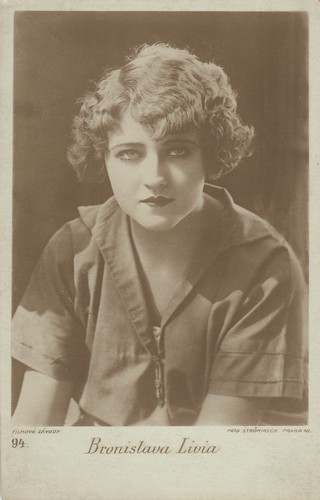
Czech postcard, no. 94. Photo: Ströminger, Praha (Prague) / Filmova Zavody. Collection: Marlene Pilaete.
Bronislava Livia (1901-?) made her film debut in 1921, after having won a beauty contest. During the 1920s, she was one of the main female stars of the Czech film industry. This actress, who was born in Japan, had rather mysterious origins. According to several sources, she might have been Romanian. At the advent of the sound film, it seems that her accent was deemed unsuitable for Czech audiences and it was in Poland that she was featured in her last film in 1932.
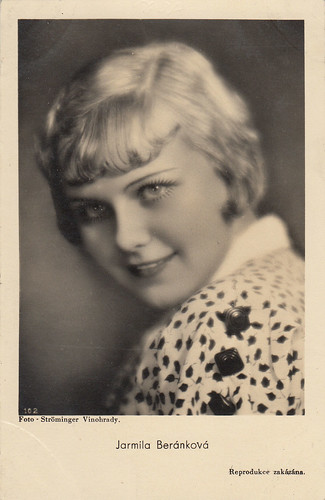
Czech postcard, no. 102. Photo: Ströminger, Vinohrady (Prague). Collection: Marlene Pilaete.
Jarmila Berankova (1919-2002) made her film debut by playing a teenage peasant girl named Pepicka in Reka (1933), which was a big hit. The young star was featured in other movies until the beginning of the 1940s. She then gave birth to two children in 1942 and 1945. Afterwards, she only worked occasionally.

Czech postcard by Bri Deglové, Praha, no. 106. Photo: Ströminger, Praha (Prague). Collection: Marlene Pilaete.
Suzanne Marwille (1895-1962) made her screen debut in 1918 and was one of the greatest stars of the silent Czech movie industry. She notably was featured in several movies directed by Martin Fric, who became her husband in 1928. She only made three talkies, all in leading roles.

Czech postcard, no. 120. Photo: Ströminger, Praha (Prague). Collection: Marlene Pilaete.
Ella Sarkova (1906 or 1907?-1991) was a popular operetta diva from the beginning of the 1930s until 1957. She made her film debut in 1931 and was featured in several films until 1938. After the War, she occasionally appeared again on the screen in secondary roles.

Czech postcard, no. 128. Photo: Ströminger, Praha (Prague). Collection: Marlene Pilaete.
Ljuba Hermanova (1913-1996) was a major Czech female singer. On stage, she was featured in operettas, revues, one-woman shows, musicals, and cabaret acts. She also performed in several theatre plays. She appeared quite regularly on the screen in the 1930s and, later, she only occasionally worked for the Czech film industry. She made her film debut in Penize nebo zivot (1932), in which she sang the famous song 'Zivot je jen nahoda'. Her long and brilliant career was only interrupted by the War and the Occupation. As she had a father who was of Jewish origin, she was forbidden to perform during that period.

Czech postcard, no. 149. Photo: Ströminger, Praha (Prague). Collection: Marlene Pilaete.
Jozka Koldovska (1905-1962) was an operetta star who worked steadily until the beginning of the 1950s. A skilled actress, she also appeared in theatre plays. Her film career was rather short and peaked from 1933 to 1935. She was especially praised for her portrayal of a modest seamstress in Svitani (1933). Totally different was her role as an amoral cabaret star transmitting a venereal disease to a naive bank clerk in Osudna chvile/Hra nahody (1935).

Czech postcard, no. 163. Photo: Ströminger, Praha (Prague). Collection: Marlene Pilaete.
A popular stage actress during the 1930s, Natasa Gollová (1912-1988) was a brilliant film star from 1939 on. Under the name of Ada Goll, she was also featured in the German film Komm zu mir züruck in 1944. At the Liberation, she was accused of collaboration, as she has had an affair with the German Wilhelm Söhnel, a prominent figure from the Czech film industry during the War. Furthermore, the fact that she had worked in a German film did not play in her favour. She was then banned from working for two years. Although she never regained her former glory, she pursued her acting career from 1947 on.
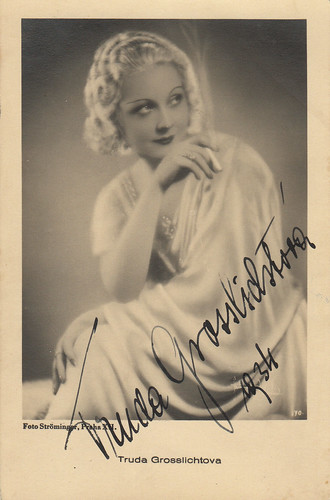
Czech postcard, no. 170. Photo: Ströminger, Praha (Prague). Collection: Marlene Pilaete. Signed in 1934.
Truda Grosslichtova (1912-1995) was one of the 1930s most popular Czech film stars and won praise for her portrayals in films such as Posledni bohém (1931), Pravo na hrich (1932), Anita v raje (1934), Hrdina jedné noci (1935), Divoch (1936) or Advokatka Vera (1937). As Tania Doll, she also starred for French audiences in Le roi bis (1932) and Professeur Cupidon (1933). During the Second World War, Truda Grosslichtova, whose father was Jewish, had to give up her acting career. In 1946, she married a Dutchman and settled in the Netherlands.

Czech postcard, no. 190. Photo: Ströminger, Praha (Prague). Collection: Marlene Pilaete.
Marketa Krausova (1895-1942) was a renowned operetta and theatre performer. She was also a film star in 1934 and 1935. She made her film debut in Zena, ktera vi ce chce (1934), adapted from Oscar Straus’ 'Eine Frau, die weiss, was sie will'. As she was Jewish, she had to give up her career at the end of the 1930s. In May 1942, ill-fated Marketa Krausova was sent to the Theresienstadt transit and concentration camp and was then deported to the Majdanek extermination camp. That’s where the life of this gifted actress abruptly ended.
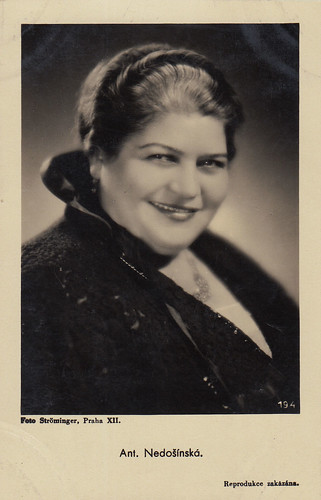
Czech postcard, no. 194. Photo: Ströminger, Praha (Prague). Collection: Marlene Pilaete.
Antonie Nedosinska (1885-1950) was already a noted stage star when made her screen debut in 1916. From 1925 to 1941, she never stopped filming and appeared in a great number of movies. Although she was sometimes used in dramatic roles, she was more often seen in comedies and she notably was a frequent partner to Theodor Pistek.
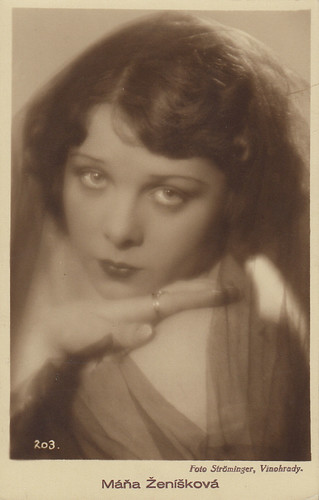
Czech postcard, no. 203. Photo: Ströminger, Vinohrady (Prague). Collection: Marlene Pilaete.
Mana Zeniskova (1909-1982) was a Czech silent film star during the second half of the 1920s. In 1930, she married actor Theodor Pistek and, after four sound films, she chose to retire to raise a family. She came back on the screen only once in Cikanska laska (1938), which was co-directed by her husband. One of her children, Theodor Pistek Jr, won the Best Costume Oscar in 1985 for Milos Forman’s Amadeus.

Czech postcard, no. 209. Photo: Ströminger, Praha (Prague). Collection: Marlene Pilaete.
Svetla Svozilova (1906-1970) was a brilliant theatre star who appeared on the stage until the end of her life. She made her screen debut in 1931 and had her first important role in Kantor Ideal (1932). Until the beginning of the 1940s, she was a popular film actress.
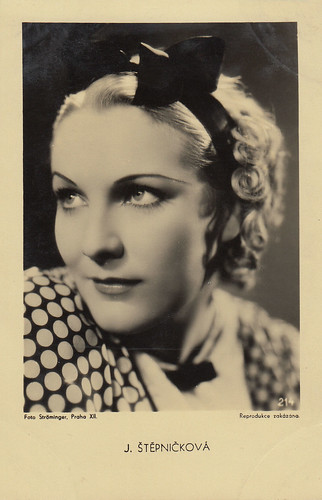
Czech postcard, no. 214. Photo: Ströminger, Praha (Prague). Collection: Marlene Pilaete.
Jirina Stepnickova (1912-1985) was an important Czech film star from 1934 to 1944. During that period, she was also a renowned stage actress. After the War, she appeared in three more films in 1947, 1949, and 1951 before she entered the worst period of her life. At the beginning of the 1950s, she tried to escape communist Czechoslovakia and was arrested. She was accused of treason and condemned to fifteen years of imprisonment. She was released after ten years and at the beginning of the 1960s, she resumed her acting career.
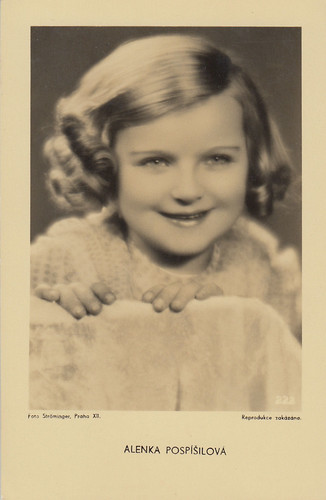
Czech postcard, no. 222. Photo: Ströminger, Praha (Prague). Collection: Marlene Pilaete.
Alen(k)a Pospisilova (1928) made her screen debut as the heroine’s illegitimate and hidden daughter in Bezdetna (1935), which made her a child-star. She was then featured in Blahové devce (1938), Ted’ zas my (1939), and Tulak Macoun (1939). Afterwards, she played some young girl’s roles in 1948 and 1949 before disappearing from the public’s sight.

Czech postcard, no. 245. Photo: Ströminger, Praha (Prague). Collection: Marlene Pilaete.
Helena Busova (1911 or 1914?-1986) became a film star thanks to her role in Hej-rup! (1934) and was especially popular during the rest of the 1930s. At the end of the 1940s, she managed to leave Czechoslovakia and settled in England, alongside her husband, war hero Karel Kasal. In 1957, the couple emigrated to Canada.

Czech postcard, no. 248. Photo: Ströminger, Praha (Prague). Collection: Marlene Pilaete.
Mary Grossova or Marie Grossová (1902-1972) was a stage star from the beginning of the 1920s until the 1960s and was especially popular in operettas. She appeared in a few silent films but it was at the advent of the sound film that her screen career really took off. In the 1930s, she was featured in about thirty films.
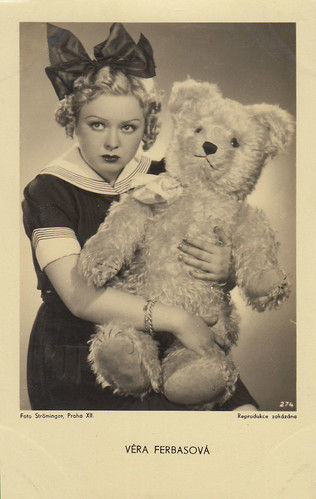
Czech postcard, no. 274. Photo: Ströminger, Praha (Prague). Collection: Marlene Pilaete.
Vera Ferbasova (1913-1976) was a famous film star in the second part of the 1930s and was especially good in comedies. She retired in 1942, as she was not too keen to work in an occupied country. Unfortunately, she never could regain her status after the end of the War. The type of films in which she had usually starred, was considered of belonging to a bygone era. Furthermore, she soon had trouble with the Communist authorities. She only could resume her film career in 1958, in secondary roles.

Czech postcard, no. 280. Photo: Ströminger, Praha (Prague). Collection: Marlene Pilaete.
A noted violinist, Mila Reymonova (1907-?) made her film debut in 1931 and was at the height of her screen career in the second half of the 1930s. Her type of beauty prevented her to be used in naive ingenue roles and she was often asked to play spies, mistresses, or actresses. As she was of Jewish origin, she wisely decided to leave Czechoslovakia at the end of the 1930s. She later pursued her violinist career on stage, on radio, and on television in the U.K. and in the U.S.A.
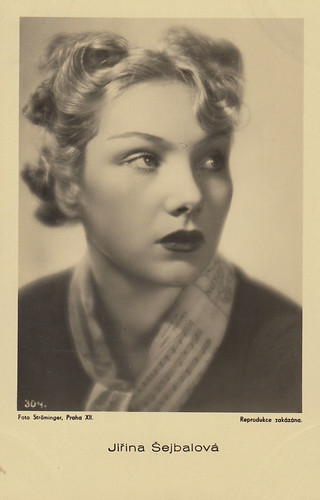
Czech postcard, no. 304. Photo: Ströminger, Praha (Prague). Collection: Marlene Pilaete.
Jirina Sejbalova (1905-1981) was a great stage actress who worked from the end of the 1920s until the beginning of the 1970s. She made her screen debut in the leading role of the silent film Hanka a Jindra (1929) and soon became a popular 1930s film star. In the 1960s, she was a teacher at the Prague Stage Arts Academy.

Czech postcard, no. 334. Photo: Ströminger, Praha (Prague). Collection: Marlene Pilaete.
Marie Glazrova (1911-2000) was a famous theatre star and worked on the stage until 1983. Her signature play was Vilem Mrstik’s 'Marysa', which she played in 1943, 1945, and 1956. From the end of the 1930s until the mid-1940s, she was also a popular film actress. Rather unjustly, it seems that the movie directors from the communist era were much less interested to use her talents.

Czech postcard, no. 300. Photo: Ströminger, Praha (Prague). Collection: Marlene Pilaete.
Czech actress Zita Kabatova (1913-2012) was a famous film star from 1936 to 1944. Under the name of Marina von Buchlow, she also appeared in two German films in 1944. After the Liberation of Czechoslovakia, the new authorities reproached her to have worked for the German film studios and she was banned from pursuing her career. It took her several years to act again. She appeared on stage in the 1950s and only made her screen comeback in 1969.
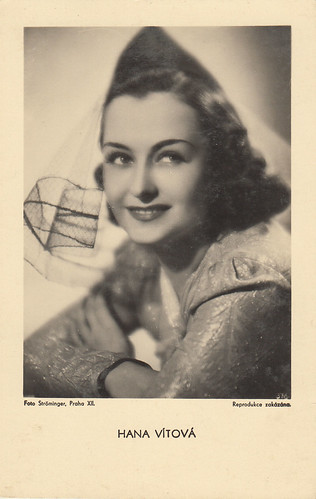
Czech postcard, no. 376. Photo: Ströminger, Praha (Prague). Collection: Marlene Pilaete.
Hana Vitova (1914-1987) was one of the major Czech film stars in the 1930s and in the first part of the 1940s. One of her most famous films was the melodrama Nocni motyl (1941). Under the name of Hanna Witt, she was featured in the German films Der zweite Schuss (1943) and Freunde (1945) and this caused her to be accused of collaboration at the Liberation. She never regained her former star status. Her comeback in 1947 didn’t relaunch her career and she only rarely appeared on the screen afterwards.

Czech postcard, no. 387. Photo: Ströminger, Praha (Prague). Collection: Marlene Pilaete.
Adina Mandlova (1910-1991) was one of the major stars of the Czech film industry from 1933 to 1944. Under the name of Lil Adina, she also was Heinz Rühmann’s partner in the German film Ich vertraue Die meine Frau an. After the Liberation of her country, she was arrested and accused of collaboration. Her work in the German studios was held against her. Furthermore, there were rumors, seemingly unfounded, that she has had an affair with the sinister Karl Hermann Frank, who was convicted of war crimes and was hanged in 1946. She was eventually released but her career and her reputation were ruined. She married a British pilot in 1947 and emigrated to England. It was there that she appeared in her last film The Fool and the Princess, in which she played a so-called Russian princess.
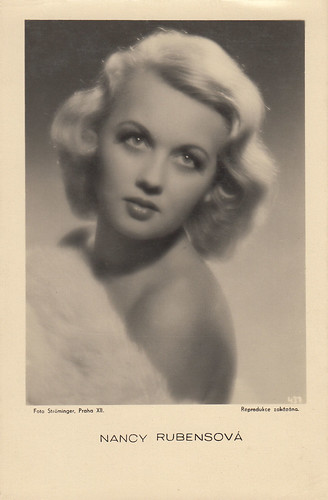
Czech postcard, no. 437. Photo: Ströminger, Praha (Prague). Collection: Marlene Pilaete.
Nancy Rubensova (1915-1994) made her screen debut by playing a spoiled and temperamental girl in Svetlo jeho oci (1936). Although most of the critics were not impressed by her talents, cinema audiences took a liking to this young and glamorous blonde star. She stayed popular until the end of the 1930s and her film career ended in 1942.

Czech postcard, no. 444. Photo: Ströminger, Praha (Prague). Collection: Marlene Pilaete.
Zorka Janu (1921-1946) was Lida Baarova’s little sister. She always preferred to work on stage but she nevertheless was featured in several films such as Ohnivé léto (1939), Cekanky (1940), Z ceskych mlynu (1941), or Kluci a rece (1944). In 1945, after the Liberation of Czechoslovakia, her world collapsed. Her sister, who had an affair with Josef Goebbels in the 1930s, was arrested and her mother died from a heart attack in October after a police interrogation. Although she never had never been guilty of any act of collaboration with the Nazis, Zorka Janu was officially banned from working. Deeply hurt by this unfair decision, she committed suicide in March 1946.

Czech postcard, no. 448. Photo: Ströminger, Praha (Prague). Collection: Marlene Pilaete.
Lida Baarova (1914-2000) made her screen debut in Kariéra Pavla Camrdy (1931). She quickly became a popular star and, until the beginning of the 1930s, appeared in many Czech films, including Ruzové kombiné (1932), Madla z cihelny (1933), Grandhotel Nevada (1935), Svadlenka (1936), Panenstvi (1937), Ohnivé léto (1939), Zivot je krasny (1940) or Turbina (1941). From 1935 until 1938, she also starred in several German films. But she also had an affair with Josef Goebbels and, when there was talk of divorce between the Minister of Propaganda and his wife, Hitler came into action. He forbade Goebbels to see Lida Baarova again and she had to stop working in Germany. Faced with uncertain work prospects in Nazi-occupied Czechoslovakia, she decided to go to Italy in 1942, where she was featured in films such as Ti conosco, mascherina! (1943) or La fornarina (1944). When the Mussolinian regime collapsed, she returned to her native country. In 1945, she was arrested and imprisoned for collaboration but, due to lack of evidence, she was eventually released in December 1946. She left Czechoslovakia in 1948 and, in the 1950s, she again appeared on the screen in Spain and in Italy, most notably in Fellini’s I Vitelloni (1953).

Czech postcard, no. 450. Photo: Ströminger, Praha (Prague). Collection: Marlene Pilaete.
Stella Majova (1923-2009) made her film debut in 1939 and quickly became a promising young star. Until 1943, she was featured in several Czech films. Afterwards, she worked mainly on stage. Nevertheless, she never completely gave up her screen career. She played for example the Princess Zpevanka in the popular fairy tale Byl jednou jeden kral (1954).

Czech postcard, no. 471. Photo: Ströminger, Praha (Prague). Collection: Marlene Pilaete.
Natasa Tanska (1929-2014) made her screen debut in Babicka (1940), which made her a child star. The producers liked her so much that she received the same salary as the established actress Terezie Brzkova, who had the title role. She was then featured in Preludium (1941) but her family soon moved to Trencin and she had to stop working. From 1947 to 1952, she again appeared in a handful of films but serious health problems finally forced her to give up her film career.
Text and postcards: Marlene Pilaete. Check out Marlene's other La Collectionneuse posts.
No comments:
Post a Comment